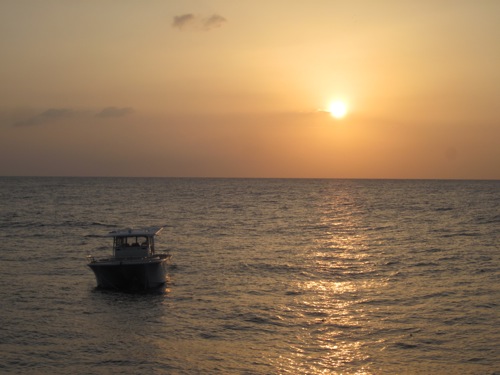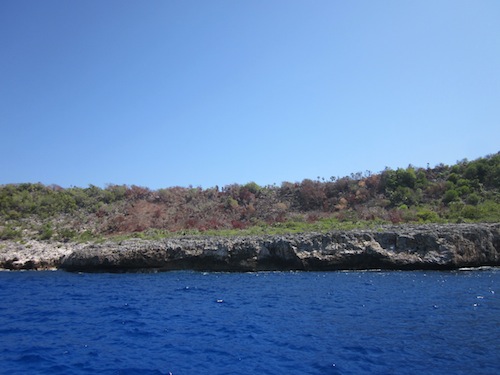The mission to Navassa wrapped up on Friday. As the sun began to set, activity on the Golden Shadow continued. Laptops whirred while everyone entered their data for the week. Those not entering data compared notes, stories, and observations from the trip. Information about fish species, coral counts, discussions with the fishers and a lot more information will be compiled and processed by all the various organizations participating in the mission.

Meanwhile, the crew secured the support vessels on the back deck of the ship. The dive equipment was packed in the dive locker for the next mission (a visit to three remote, unpopulated atolls off the coast of Colombia in April). Camera and video equipment were carefully stored, and the research supplies were inventoried to determine what to replenish. By Saturday morning, the Shadow was back in Port Antonio, Jamaica.

The Mission Navassa science team has gathered valuable information to be processed and shared, not just with the high schools below, but also with researchers, scientists, and educators around the world. The Global Reef Expedition is committed to Science Without Borders®, a Living Oceans Foundation initiative to promote public awareness of the need to preserve, protect and restore the world’s oceans and aquatic resources. Lessons learned from Navassa add one more link in the quest to preserve and protect coral reef environments.
Virtual Connections-Part II
The science team continued to receive and respond to questions from high school students in Washington and Arizona.
Gig Harbor High School, Gig Harbor, WA
Q. How long are your research dives?
A. Dives can take up to 65 minutes with a bottom depth limit of 30 meters depending on air consumption. Deeper dives require shorter maximum times, especially on the 2nd or 3rd dive of the day. – Judy Lang, Atlantic and Gulf Rapid Reef Assessment

Q. How do fish populations in Navassa compare to Pedro Bank in Jamaica?
A. Fish communities in Navassa are showing some signs of overfishing, with few large groupers and other large predators, and a declining population of herbivores. We still have large populations of parrotfish and surgeonfishes, the two species that eat much of the seaweed, but only a small number are large. We also have an increasing population of lionfish, which are non-native and are voracious predators. It is likely that the fish community will shift towards smaller species with complete loss of some of the larger target species, unless fishing is prohibited.
The fishing is very different compared to Pedro Bank. First, there are fewer fishermen on Navassa. They operate in non-motorized rowboats (with sails). They primarily use hand-lines and low numbers of handmade (bamboo) fish pots. On Pedro Bank, the dominant fishing practice is “compressor fishing.” Two to three fishers will dive using hookah at depths of 40-80 feet and catch fish with spearguns. Each fisher spends 2-3 hours on the bottom at a time, retrieving 80-100 lbs of fish per trip. The dominant component of their catch is parrotfish, mostly small (5-6 inches) because few other large fish are left. The second, most common method is using fish pots; these are also handmade using sticks and wire mesh. They are larger, and have a smaller opening. They are deployed using motorized boats, with some fishermen dropping 20-30 at a time. The dominant catch in fishpots is surgeonfish, which is not targeted on Navassa. – Andy Bruckner, Living Oceans Foundation

Q. What can we do to improve coral reefs?
A. People worldwide need to recognize the value of a healthy coral reef ecosystem, as well as their vulnerability to human abuse. We have few means to successfully restore corals reef back to health once they are degraded so protecting our existing natural reefs and minimize existing threats is key. Threats to coral reefs include: 1) physically destroying coral reefs (for example, dynamite fishing on reefs still occurs in the Indo-Pacific Ocean); 2) coastal development and land-based pollution near coral reefs; and 3) fishing pressure on coral reef fishes and invertebrates like conch and lobster; and 4) our dependence on fossil fuels.
As an individual, there are actions you can take to improve coral reefs. If you enjoy seafood, be sure to buy sustainable fishes and shellfish to support good fisheries management and avoid over-fished species. Reduce your use of fertilizer and pesticides on your lawns and garden, so run-off doesn’t flow to our coastal water, which reduces seawater quality. Lastly, we all need to take an active role in reducing our carbon footprint to halt climate change and ocean acidification. Taking public transit, using your bicycle, carpooling, and saving electricity are all valid steps to use less fossil fuel and help improve the state of the oceans for coral reefs. – Brittany Huntington, NOAA-Southeast Fisheries Science Center
Q. Are there year-round resident species on Navassa?
A. Yes, Navassa’s seabirds. Extensive mining of the island’s guano deposits suggest that the island was once a significant breeding area for seabirds. Five species of seabirds are still recorded as breeding on Navassa, including magnificent frigate birds (Frigate magnificens), red-footed boobies (Sula sula), brown noddies (Anous stolidus), white-tailed tropic birds (Phaethon lepturus) and bridled terns (Onychyrona ethetus). The federally listed white-crowned pigeon (Patagonioenas leucocephala) also breeds on the island albeit in low numbers, and the island has significant potential as a breeding site for masked booby (Sula dactylatra) and Audubon’s shearwater. – Aurora Alifano, Island Conservation
Corona del Sol High School, Tempe, AZ
Q. Is there any way to prevent the coral disease from spreading to other corals?
A. The best way to prevent spread of disease is to reduce conditions that lower the corals’ resistance. This mainly involves addressing poor water quality through better land use practices (e.g. eliminating sewage discharge, reducing agricultural run-off, better coastal development practices) and reducing fishing pressure so that critical herbivore and detritivore populations have a chance to rebound. If the ecosystem is balanced and water quality is good, diseases will be less common. – Andy Bruckner, Living Oceans Foundation
Q. Is the population of the birds around the Caribbean Islands decreasing due to the loss of coral reefs?
A. Seabird populations in the Caribbean are threatened, but we need more research to define how the loss of coral reefs impacts the bird populations. Major threats to seabirds include mortality in long-line fisheries and gill-nets, oil spills, and the impact of invasive alien species (in particular predation by rodents and cats) at the breeding colonies. Additional threats to breeding sites of seabirds are habitat loss and degradation from coastal development, logging and pollution. Many species of seabirds are exposed to a combination of these threats throughout their life history. We can mitigate or even reverse some of these threats to benefit Caribbean seabirds. – Aurora Alifano, Island Conservation
Q. How much of Navassa’s perimeter contains coral reefs?
A. The sides of the island are nearly vertical and coral reef organisms cover the walls from the waterline to the base at around 80 feet on all sides of the island that we have seen. There are deep patch reefs off the north and south coasts, as well. The east side of the island is the windward side and has much less reef-type development due to the high wave energy. – Dana Williams, University of Miami

Q. What species of fish did you encounter/observe the most?
A. Several things are striking about the fish diversity here. There are swarms of small fish that eat plankton (planktivores) everywhere–blue and brown chromis and creole wrasse–very colorful and abundant. On the reef we see quite a few small herbivores (damselfish, parrotfish and blue tang are really common), along with a rainbow of other beautiful fish that each play an important role in the reef. What we don’t see are many predators, such as groupers, snappers, jacks, and barracudas. This is alarming as they are an important part of keeping the reef community in balance. We are also alarmed at the number of large lionfish we are seeing. These invasive species showed up in 2009 for the first time and we are encountering them on almost every dive. They have no natural enemies in the Caribbean, so they are taking a huge toll on the local small fish communities. For me, the most exciting thing is seeing new fish for the first time. Navassa is the first place I’ve ever seen the Sargassum triggerfish, and I also really enjoy seeing black durgons, fairy basslets, longsnout butterfly fishes, and small colorful hamlets that I don’t see often back home in Florida. – Jennifer Schull, NOAA-Southeast Fisheries Science Center
(Photos/Images by: 1, 2, 4, 5 Eddie Gonzalez, 3 Brian Beck)
To follow along and see more photos, please visit us on Facebook! You can also follow the expedition on our Global Reef Expedition page, where there is more information about our research and our team members.